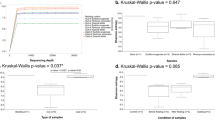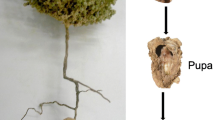Abstract
Chinese cordyceps is a well-known fungus-larva complex with medicinal and economic importance. At present the occurrence of Chinese cordyceps has not been fully illuminated. In this study, the microbial diversities of fertilized Thitarodes eggs from sites A (high occurrence rates of Chinese cordyceps), B (low occurrence rates), and C (no Chinese cordyceps) were analyzed using 16S rRNA and ITS gene-sequencing technique. The previous sequencing data of soil from the same sites were conjointly analyzed. The results showed that bacterial communities among the eggs were significantly different. The bacterial diversity and evenness were much higher on site A. Wolbachia was overwhelmingly predominant in the eggs of sites B and C, while Spiroplasma showed preference on site A. The fungal between-group differences in the eggs were not as significant as that of bacteria. Purpureocillium in Cordyceps-related families showed preference on site A. Wolbachia, Spiroplasma, and Purpureocillium were inferred to be closely related to Chinese cordyceps occurrence. Intra-kingdom and inter-kingdom network analyses suggest that closer correlations of microbial communities (especially closer fungal positive correlations) in fertilized eggs might promote Chinese cordyceps occurrence. Besides, metabolic pathway analysis showed that in fertilized eggs or soil the number of bacterial metabolic pathways with significant differences in every comparison between two sites was greater than that of fungi. Collectively, this study provides novel information about the occurrence of Chinese cordyceps, contributing to the large-scale artificial cultivation of Chinese cordyceps.





Similar content being viewed by others
Data Availability
Most data generated or analysed during this study are included in this published article and its supplementary information files, other data are available from the corresponding authors upon reasonable request.
Code Availability
Not available.
References
Zhang Y, Li E, Wang C, Li Y, Liu X (2012) Ophiocordyceps sinensis, the flagship fungus of China: terminology, life strategy and ecology. Mycology 3(1):2–10. https://doi.org/10.1080/21501203.2011.654354
Liu Y, Li QZ, Li LD, Zhou XW (2021) Immunostimulatory effects of the intracellular polysaccharides isolated from liquid culture of Ophiocordyceps sinensis (Ascomycetes) on RAW264.7 cells via the MAPK and P13K/Akt signaling pathways. J Ethnopharmacol 275:114130. https://doi.org/10.1016/j.jep.2021.114130
Zhang XM, Tang DX, Li QQ, Wang YB, Xu ZH, Li WJ, Yu H (2021) Complex microbial communities inhabiting natural Cordyceps militaris and the habitat soil and their predicted functions. Antonie Van Leeuwenhoek 114(4):465–477. https://doi.org/10.1007/s10482-021-01534-6
Wang XL, Yao YJ (2011) Host insect species of Ophiocordyceps sinensis: a review. ZooKeys 127(127):43–59. https://doi.org/10.3897/zookeys.127.802
Liu Y, Shi M, Liu X, Xie J, Yang R, Ma Q, Guo L (2021) Arsenic transfer along the soil-sclerotium-stroma chain in Chinese cordyceps and the related health risk assessment. PeerJ 9:e11023. https://doi.org/10.7717/peerj.11023
Shrestha UB, Bawa KS (2014) Impact of climate change on potential distribution of Chinese caterpillar fungus (Ophiocordyceps sinensis) in Nepal Himalaya. PLoS ONE 9(9):e106405. https://doi.org/10.1371/journal.pone.0106405
He J (2018) Harvest and trade of caterpillar mushroom (Ophiocordyceps sinensis) and the implications for sustainable use in the Tibet region of southwest China. J Ethnopharmacol 221:86–90. https://doi.org/10.1016/j.jep.2018.04.022
Li X, Liu Q, Li WJ, Li QP, Qian ZM, Liu XZ, Dong CH (2019) A breakthrough in the artificial cultivation of Chinese cordyceps on a large-scale and its impact on science, the economy, and industry. Crit Rev Biotechnol 39(2):181–191. https://doi.org/10.1080/07388551.2018.1531820
Wang J, Xue F, Huang R, Jiang Y, Sheng R (1997) Anatomy of internal structure of the larva of Napialus hunanensis Chu et Wang (Lepidoptera:Hepialidae). Acta Agric Univ Jiangxiensis 16(2):7–10. https://doi.org/10.13836/j.jjau.1997026
Chen J, Gao ZX, Yu H (1991) Observation on egg’s feature and chorionic ultrastructure of swiftmoth (Hepialus obliturcus Chu ct Wang ). Zhejiang Nong Ye Da Xue Xue Bao 39:379–383
Sommer F, Bäckhed F (2013) The gut microbiota–masters of host development and physiology. Nat Rev Microbiol 11(4):227–238. https://doi.org/10.1038/nrmicro2974
Chen YQ, Wang N, Qu L, Li T, Zhang W (2001) Determination of the anamorph of Cordyceps sinensis inferred from the analysis of the ribosomal DNA internal transcribed spacers and 5.8S rDNA. Biochem Syst Ecol 29(6):597–607. https://doi.org/10.1016/s0305-1978(00)00100-9
Liu XJ, Guo YL, Yu YX, Zeng WJM (1989) Isolation and identification of the anamorphic state of Cordyceps sinensis (Berk.) Sacc. Acta Mycol Sin 8:35–40
Rong L, Li G, Zhang Y, Xiao Y, Qiao Y, Yang M, Wei L, Bi H, Gao T (2021) Structure and immunomodulatory activity of a water-soluble α-glucan from Hirsutella sinensis mycelia. Int J Biol Macromol 189:857–868. https://doi.org/10.1016/j.ijbiomac.2021.08.185
Li YL, Yao YS, Zhang ZH, Liu X, Xu HF, Ma SL, Wu ZM, Zhu JS (2016) Synergy of fungal complexes isolated from the intestines of Hepialus lagii larvae in increasing infection potency. J Fungal Res 14(2):96–112. https://doi.org/10.13341/j.jfr.2014.1067
Zhang Y (2016) Studies on the relationship between the strains related to Ophiocordyceps and Hirsutella sinensis. Dissertation, Lanzhou Jiaotong University
Shao JL, Lai B, Jiang W, Wang JT, Hong YH, Chen FB, Tan SQ, Guo LX (2019) Diversity and co-occurrence patterns of soil bacterial and fungal communities of Chinese Cordyceps habitats at Shergyla Mountain, Tibet: implications for the occurrence. Microorganisms 7(9):284. https://doi.org/10.3390/microorganisms7090284
Guo LX, Hong YH, Zhou QZ, Zhu Q, Xu XM, Wang JH (2017) Fungus-larva relation in the formation of Cordyceps sinensis as revealed by stable carbon isotope analysis. Sci Rep 7(1):7789. https://doi.org/10.1038/s41598-018-23242-4
Guo LX, Xu XM, Liang FR, Yuan JP, Peng J, Wu CF, Wang JH (2015) Morphological observations and fatty acid composition of indoor-cultivated Cordyceps sinensis at a high-altitude laboratory on Sejila Mountain, Tibet. PLoS ONE 10(5):e0126095. https://doi.org/10.1371/journal.pone.0126095
Liang Y, Hong Y, Mai Z, Zhu Q, Guo L (2019) Internal and external microbial community of the Thitarodes moth, the host of Ophiocordyceps sinensis. Microorganisms 7(11):517. https://doi.org/10.3390/microorganisms7110517
Douglas GM, Maffei VJ, Zaneveld JR, Yurgel SN, Brown JR, Taylor CM, Huttenhower C, Langille MGI (2020) PICRUSt2 for prediction of metagenome functions. Nat Biotechnol 38(6):685–688. https://doi.org/10.1038/s41587-020-0548-6
Zheng P, Xia YL, Zhang SW, Wang CS (2013) Genetics of Cordyceps and related fungi. Appl Microbiol Biotechnol 97(7):2797–2804. https://doi.org/10.1007/s00253-013-4771-7
Li Y, Wang XL, Jiao L, Jiang Y, Li H, Jiang SP, Lhosumtseiring N, Fu SZ, Dong CH, Zhan Y (2011) A survey of the geographic distribution of Ophiocordyceps sinensis. J Microbiol 49(6):913–919. https://doi.org/10.1007/s12275-011-1193-z
Zhang ZH, Ma SL, Xu HF, Liu X, Li YL (2009) Analysis of change of microbial flora in intestine channel of Hepialus larva which was host of Cordyceps sinensis in Qinghai Province. Chin Qinghai J Anim Vet Sci 39(6):17–19
Liu G, Zheng X, Long H, Rao Z, Cao L, Han R (2021) Gut bacterial and fungal communities of the wild and laboratory-reared Thitarodes larvae, host of the Chinese medicinal fungus Ophiocordyceps sinensis on Tibetan Plateau. Insects 12(4):327. https://doi.org/10.3390/insects12040327
de Menezes AB, Richardson AE, Thrall PH (2017) Linking fungal-bacterial co-occurrences to soil ecosystem function. Curr Opin Microbiol 37:135–141. https://doi.org/10.1016/j.mib.2017.06.006
Liang ZQ, Han YF, Liang JD, Dong X, Du W (2010) Issues of concern in the studies of Ophiocordyceps sinensis. Microbiology China 37:1692–1697
Saghrouni F, Saidi W, Ben Said Z, Gheith S, Ben Said M, Ranque S, Denguezli M (2013) Cutaneous hyalohyphomycosis caused by Purpureocillium lilacinum in an immunocompetent patient: case report and review. Med Mycol 51(6):664–668. https://doi.org/10.3109/13693786.2012.757656
Silva SD, Carneiro R, Faria M, Souza DA, Monnerat RG, Lopes RB (2017) Evaluation of Pochonia chlamydosporia and Purpureocillium lilacinum for suppression of Meloidogyne enterolobii on tomato and banana. J Nematol 49(1):77–85. https://doi.org/10.21307/jofnem-2017-047
Chen W, Hu Q (2021) Secondary metabolites of Purpureocillium lilacinum. Molecules 27(1):18. https://doi.org/10.3390/molecules27010018
Mikami Y, Yazawa K, Fukushima K, Arai T, Udagawa S, Samson RA (1989) Paecilotoxin production in clinical or terrestrial isolates of Paecilomyces lilacinus strains. Mycopathologia 108(3):195–199. https://doi.org/10.1007/bf00436225
Eberhard W, Pacheco-Esquivel J, Carrasco-Rueda F, Christopher Y, Gonzalez C, Ramos D, Urbina H, Blackwell M (2014) Zombie bugs? The fungus Purpureocillium cf. lilacinum may manipulate the behavior of its host bug Edessa rufomarginata. Mycologia 106(6):1065–1072. https://doi.org/10.3852/13-264
Zhong X, Peng QY, Li SS, Chen H, Sun HX, Zhang GR, Liu X (2014) Detection of Ophiocordyceps sinensis in the roots of plants in alpine meadows by nested-touchdown polymerase chain reaction. Fungal Biol 118(4):359–363. https://doi.org/10.1016/j.funbio.2013.12.005
Zhang Y, Xu L, Zhang S, Liu X, An Z, Wang M, Guo Y (2009) Genetic diversity of Ophiocordyceps sinensis, a medicinal fungus endemic to the Tibetan Plateau: implications for its evolution and conservation. BMC Evol Biol 9:290. https://doi.org/10.1186/1471-2148-9-290
Lei W, Zhang G, Peng Q, Liu X (2015) Development of Ophiocordyceps sinensis through plant-mediated interkingdom host colonization. Int J Mol Sci 16(8):17482–17493. https://doi.org/10.3390/ijms160817482
Liu Y, Wang XY, Gao ZT, Han JP, Xiang L (2017) Detection of Ophiocordyceps sinensis and its common adulterates using species-specific primers. Front Microbiol 8:1179. https://doi.org/10.3389/fmicb.2017.01179
Sung GH, Hywel-Jones NL, Sung JM, Luangsa-Ard JJ, Shrestha B, Spatafora JW (2007) Phylogenetic classification of Cordyceps and the clavicipitaceous fungi. Stud Mycol 57:5–59. https://doi.org/10.3114/sim.2007.57.01
Werren JH, Baldo L, Clark ME (2008) Wolbachia: master manipulators of invertebrate biology. Nat Rev Microbiol 6(10):741–751. https://doi.org/10.1038/nrmicro1969
Teixeira L, Ferreira A, Ashburner M (2008) The bacterial symbiont Wolbachia induces resistance to RNA viral infections in Drosophila melanogaster. PLoS Biol 6(12):e2. https://doi.org/10.1371/journal.pbio.1000002
Zug R, Hammerstein P (2015) Wolbachia and the insect immune system: what reactive oxygen species can tell us about the mechanisms of Wolbachia-host interactions. Front Microbiol 6:1201. https://doi.org/10.3389/fmicb.2015.01201
Zug R, Hammerstein P (2015) Bad guys turned nice? A critical assessment of Wolbachia mutualisms in arthropod hosts. Biol Rev Camb Philos Soc 90(1):89–111. https://doi.org/10.1111/brv.12098
Lu P, Bian G, Pan X, Xi Z (2012) Wolbachia induces density-dependent inhibition to dengue virus in mosquito cells. PLoS Negl Trop Dis 6(7):e1754. https://doi.org/10.1371/journal.pntd.0001754
Tabata J, Hattori Y, Sakamoto H, Yukuhiro F, Fujii T, Kugimiya S, Mochizuki A, Ishikawa Y, Kageyama D (2011) Male killing and incomplete inheritance of a novel Spiroplasma in the moth Ostrinia zaguliaevi. Microb Ecol 61(2):254–263. https://doi.org/10.1007/s00248-010-9799-y
Herren JK, Lemaitre B (2011) Spiroplasma and host immunity: activation of humoral immune responses increases endosymbiont load and susceptibility to certain Gram-negative bacterial pathogens in Drosophila melanogaster. Cell Microbiol 13(9):1385–1396. https://doi.org/10.1111/j.1462-5822.2011.01627.x
Goto S, Anbutsu H, Fukatsu T (2006) Asymmetrical interactions between Wolbachia and Spiroplasma endosymbionts coexisting in the same insect host. Appl Environ Microbiol 72(7):4805–4810. https://doi.org/10.1128/aem.00416-06
Acknowledgements
The authors gratefully acknowledge Ozimeks Biotech Co., Ltd. (Shenzhen, Guangdong, China) for the sequencing.
Funding
This work was supported by the National Natural Science Foundation of China (No. 81303155), the Natural Science Foundation of Guangdong Province (Nos. 2018A030313094, 2020A151501457), the Discipline Construction Project of Guangdong Medical University (No. 4SG21014G), the “Group-type” Special Supporting Project for Educational Talents in Universities (No. 4SG19057G), and the Project for Young Innovative Talents in Ordinary Higher University of Guangdong Province (No. 2018GkQNCX050).
Author information
Authors and Affiliations
Contributions
LXG conceived and designed the experiments. ZHM, YHH, CJL, and QYZ performed the experiments and analyzed the data. LXG and YHH wrote the paper. All authors have read and agreed to the published version of the manuscript.
Corresponding author
Ethics declarations
Conflict of interest
The authors declare that they have no conflicts of interest.
Ethical Approval
Not applicable.
Consent to Participate
Not applicable.
Consent for Publication
The paper submission and publication have been approved by all co-authors as well as by the institutes where the work has been carried out. This statement is addressed to individuals participants in studies (https://www.springer.com/gp/editorial-policies/informed-consent).
Additional information
Publisher's Note
Springer Nature remains neutral with regard to jurisdictional claims in published maps and institutional affiliations.
Supplementary Information
Below is the link to the electronic supplementary material.
Rights and permissions
About this article
Cite this article
Hong, YH., Mai, ZH., Li, CJ. et al. Microbial Diversity Analyses of Fertilized Thitarodes Eggs and Soil Provide New Clues About the Occurrence of Chinese Cordyceps. Curr Microbiol 79, 229 (2022). https://doi.org/10.1007/s00284-022-02919-0
Received:
Accepted:
Published:
DOI: https://doi.org/10.1007/s00284-022-02919-0




